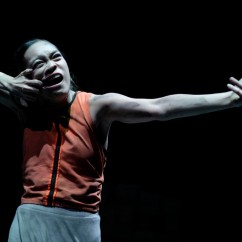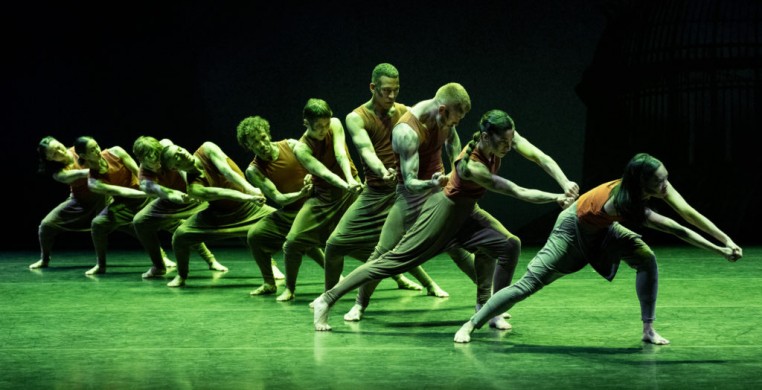Times have changed since the release of Rudyard Kipling’s The Jungle Book, and London-based Akram Khan Company landed in Chicago’s Harris Theater November 9-11 to reflect these transformations. A regenerative masterpiece, Akram’s “Jungle Book reimagined” was beyond a production. It was a fully immersive revelation into what matters most—the bare necessities.
When Khan and I last spoke, “Jungle Book reimagined” was in its infancy stage. Pulling from his theatrical and Kathak dance roots, coupled with the seed his mother planted for passionate storytelling, he was thrilled by the choreographic possibilities and the opportunity to reinterpret a near and dear classic.
After two years of development, a talented team crystallized Akram’s vision. Collaborators included Writer Tariq Jordan, Dramaturgical Advisor Sharon Clark, Composer Jocelyn Pook, Sound Designer Gareth Fry, Visual Stage Designer Miriam Buether and Art Direction and Director of Animation Adam Smith.
In contrast to his last production, “Creature,” Khan consciously shifted to a physically leaner and more sustainable set, focusing almost solely on technology and gorgeously grounded motion to carry the story. Making use of projection, live animation designed by Adam Smith, and stunning lighting effects envisioned by Michael Hulls, “Jungle Book reimagined” set out to practice what it preached in this moment of intense climate change: live harmoniously with nature or be destroyed by it.
The tone of the opening scene was as serious as a flag being lowered to half-staff. Non-locomotive dancers froze time as the scrim ascended. Alternating tones of red and fluorescent green illuminated the statuesque figures. Khan’s signature radio interludes, also present in “Creature,” added a touch of urgency.
As the special effects dissolved ten dancers into an animated rainstorm, we were submerged into what appeared to be a technological ship. Words actually fail me because what we experienced was a 3-D immersion of physical, technical and spiritual prowess.
In the midst of being catapulted into uncharted terrain, theatrically speaking, we were greeted by the familiar main character, Mowgli, reimagined as a woman embodied and danced by Jan Mikaela Villanueva [on November 11th].
 Jan Mikaela Villanueva as "Mowgli"; Photo by Camilla Greenwell
Jan Mikaela Villanueva as "Mowgli"; Photo by Camilla Greenwell
Emerging from an animated flock of birds and dolphins underneath a glowing full moon, Mowgli, who was separated from her human family, set out on a turbulent quest for higher ground as she escaped rising sea levels. The games really began when Mowgli encountered Raksha and Rama, two wolves with opposing views of humanity. Now, displaced, she had to unearth her animalistic essence to survive and be a contributor in this new animal-led existence.
Mowgli’s adventures continued as she encountered Bassheera an albino panther and Baloo, a big ole dancing bear. The trio was a joy to witness with their unexpected bodily humor, and the innovative ways they navigated the depths of the earth on stage during their quest for food, panting, tugging at their limbs, sweeping their backsides from right to left. Intensely grounded, animalistic crawls swept the stage for extended durations. They interacted like capoeira, instinctive, playful and unusually convincing. The line between animal and human was obscure. I would go as far to say there were very few “lines” in this entire production. We were bearing witness to constellations and combustions, all elements from the script, sound, movement quality and animation conversing as a unit. I’ve only seen this level of cohesive and pure oneness from choreographers rooted in Bharatanatyam and Kathak.
Act two intensified the story through movement and heightened the multi-media extravagance. As Mowgli was taken into a ransacked warehouse by lab monkeys, the audience was also taken to another dimension, a foreshadowing of the evils that await us if we continue to aim to dominate nature rather than cohabitate.
A post-apocalyptic tone heightened with quick fluid extensions. Elements of water reappeared this time through a fury of animated thundershowers. We began to see lines for the first time through the wooden boxes, at times incorporated within the flow of the choreography. A single line of the cast erupted into a windmill, leaning from side to side creating a cohesive combustion of energy. Periodic gunshots rocked our core as we were reminded of our vulnerability; we were not safe in this science experiment. The humans were on a quest for destruction and Mowgli was ready to take fierce action as an ally to the animals.
In my mind, I revisited an earlier nurturing scene where our nervous system was reset by the larger-than-life, cloud-like appearance of animated elephants or the voice of a mother that seamlessly emerged, reminding Mowgli that she stems from a people with honor and respect. “We are within nature, not separate from it,” spoke the animated elephant. Often revered as a symbol of wisdom and fertility in India, the elephant was a nurturing incorporation of the mother energy within Khan’s version of the Jungle Book. In the past, Khan has been quite vocal about the significant role his mother played in his love of listening to and rewriting stories throughout his childhood. The inclusion of the voice of the mother in many of his works speaks to his genuine devotion to mothers and the role they play in taking care of all things.
I can see myself hitting the streets after exiting the portal that was “Jungle Book Reimagined,” traveling to multiple cities to re-experience the phenomena with family and friends. But more importantly, I can see how elements of the work have landed on me in my daily life. Experiencing a work like this, you don’t leave as you arrive. You’ll find yourself like Mowgli, ready to take action where it counts. Asking how you can be a better steward of the earth in your home, at work, through your transportation, artistically in the ways you present, and above all, remaining open to unlearning our old ways.

